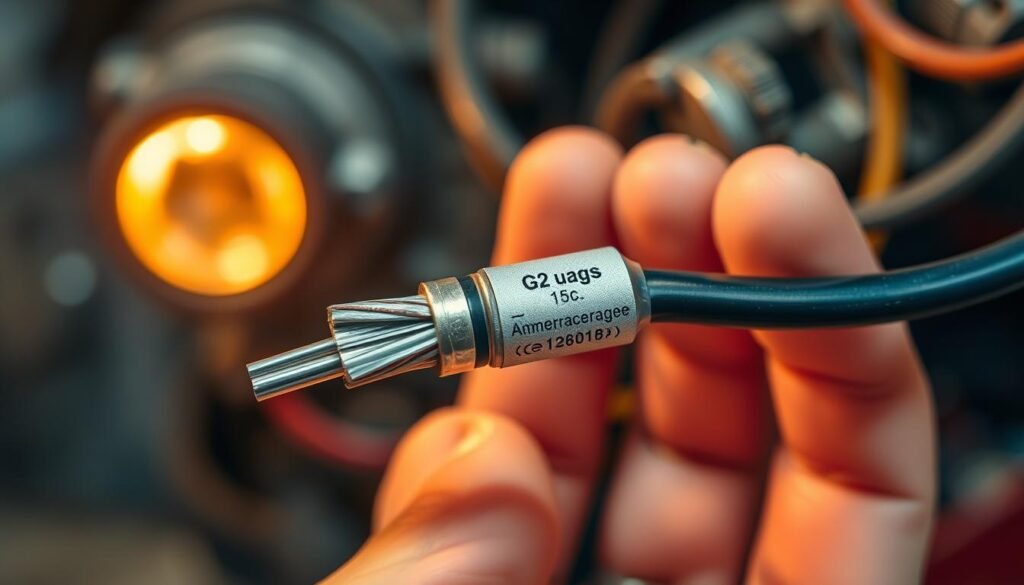What Is The Amperage On A Ford AWG Wire Guide? Essential Info
What is the amperage on a Ford AWG wire? It’s key to your Ford’s electrical system’s safety and efficiency. Amperage shows the electrical current amount a wire can handle.
It changes based on the American Wire Gauge (AWG) used. Picking the right gauge avoids electrical problems later.
To pick the right wire gauge, look at factors like distance, load needs, and ampacity. Knowing the amp draw of your parts will guide you.
For minor loads under 60 amps, use 8 AWG wire if it’s a short distance. For major loads over 250 amps, 1/0 AWG wire is best for short distances.
We will also explain why the right gauge is crucial for great electrical performance and avoiding voltage drops. With this knowledge, you can dodge electrical issues.
Your vehicle will run well. Let’s dive in and learn all about Ford AWG wires and their amperage capabilities.
Knowing AWG: American Wire Gauge Explained
AWG, or American Wire Gauge, standardizes wire sizes. This means a lower AWG number equals a thicker wire, able to carry more current.
It’s key to know about American wire gauges for Ford cars. This knowledge affects your vehicle’s electrical system’s performance and safety.
Picking the right Ford wire gauge is crucial for matching your car’s amperage needs. One common wire is the 2 Gauge Welding Cable, usually found in battery setups for high-output alternators.
This thicker cable ensures a steady electricity flow, even under heavy use. For your Ford, choosing the right wire gauge is vital for handling electrical loads properly.
For electrical setups needing 0-60 amps, 8 AWG wire works well for short distances, under 5 feet. If the wire runs longer, like 20-30 feet, you’d consider 4 AWG, 2 AWG, or 1 AWG.
And for currents over 100 amps, 6 AWG fits short distances, but you’ll need thicker wires for longer runs. This advice applies to various Ford vehicles.
When deciding between copper and aluminum wires, know that copper offers better conductivity. However, aluminum could save you money.
But, installing aluminum needs extra care to prevent problems later. Knowing these details helps you choose wisely, keeping your Ford’s electrical system running well.
Importance of Choosing The Right Wire Gauge
Choosing the right wire gauge is key for the safety and efficiency of Ford vehicles. It ensures the electrical system works well and lasts longer.
If the wire gauge is wrong, it can cause overheating, voltage issues, and shorten the system’s life. Picking the correct wire size affects the wire amp rating for Ford vehicles.
For systems using 0-60 amps, 8 AWG wire is ideal for lengths under 5 feet. For 60-100 amps, 6 AWG wire fits the bill for the same distance.
When current needs go up, choosing the right wire is even more important. For systems needing 100-150 amps, 4 AWG wire is perfect for under 5 feet.
As wires get longer, the choice of gauge changes. For 60-100 amp systems up to 10 feet, 4 AWG wire works well.
And for 100-150 amps over the same distance, 2 AWG wire is the way to go. Knowing this helps avoid dangers and keeps your vehicle’s electrics running smoothly.
To further clarify, here’s a table showing wire gauge choices by amperage and distance:
| Amperage Range | Wire Gauge (AWG) | Distance |
|---|---|---|
| 0-60 amps | 8 AWG | Less than 5 feet |
| 60-100 amps | 6 AWG | Less than 5 feet |
| 100-150 amps | 4 AWG | Less than 5 feet |
| 150-190 amps | 4 AWG | Less than 5 feet |
| 190-250 amps | 2 AWG | Less than 5 feet |
| 250-300 amps | 1/0 AWG | Less than 5 feet |
| 60-100 amps | 4 AWG | 5-10 feet |
| 100-150 amps | 2 AWG | 5-10 feet |
| 150-190 amps | 1 AWG | 5-10 feet |
Knowing how to choose the right wire is key for anyone working on cars. By following Ford’s wiring standards and using the right wire gauge, you protect the vehicle’s electrical system.
This keeps your vehicle running better for longer.
Factors Affecting Amperage Capacity in Ford Vehicles
It’s important to know what affects the amperage capacity in your Ford’s electrical system.
Many factors play a part, especially with Ford vehicle electrical specifics. Wire size and length matter a lot.
Longer wires need to be thicker to keep voltage drops low. Voltage drops should stay under 3% to work best.
High temperatures over 50°C (122°F) cut ampacity by 15%, which affects vehicle performance. Also, loads over 20 minutes add 25% more current, requiring careful wire choice.
Wires lose up to 30% capacity if they’re bundled or insulated. Matching wire size to Ford’s guidelines is key for safety.
A 1500W inverter at 12V might use up to 125A. But efficiency can raise this to about 165A. The right fuse size is critical to prevent fires.
Getting these parameters right ensures your Ford’s electrical system works well. Choosing the correct wires keeps things safe and efficient.
| Current Range (Amps) | Wire Gauge | Length Recommendation |
|---|---|---|
| 0-60 | 8 AWG | Less than 5 feet |
| 60-100 | 6 AWG | Less than 5 feet |
| 100-150 | 4 AWG | Less than 5 feet |
| 150-190 | 4 AWG | Less than 5 feet |
| 190-250 | 2 AWG | Less than 5 feet |
| 250-300 | 1/0 AWG | Less than 5 feet |

Recommended AWG Wire Sizes For Ford Vehicles
Choosing the right American wire gauge for Ford vehicles is key for both safety and performance.
Here, you’ll find which wire sizes work best based on how much electric current they carry and their length. This is essential for different parts of Ford vehicles.
| Amperage Range | Wire Length | Recommended Wire Gauge |
|---|---|---|
| 0-60 amps | Less than 5 feet | 8 AWG |
| 60-100 amps | Less than 5 feet | 6 AWG |
| 60-100 amps | 5-10 feet | 4 AWG, 1 AWG, 1/0 AWG, 2/0 AWG |
| 100-150 amps | Less than 5 feet | 4 AWG |
| 100-150 amps | 20-30 feet | 2 AWG, 1/0 AWG, 2/0 AWG, 3/0 AWG |
| 150-190 amps | Less than 5 feet | 4 AWG |
| 190-250 amps | Less than 5 feet | 2 AWG |
| 250-300 amps | Less than 5 feet | 1/0 AWG |
| 250-300 amps | Longer distances | 2/0 AWG, 3/0 AWG, 4/0 AWG |
Following these wire size recommendations for Ford vehicles helps with efficient power flow. This is crucial when making upgrades, like a new alternator, or installing extras.
Make sure the wire size matches the power needed, especially for the most important systems.

What is The Amperage On A Ford AWG Wire?
Knowing the amperage of a Ford AWG wire is vital for the electrical systems to work right and safely. Each Ford vehicle has wiring systems with different amperage ratings.
This depends on the model and its use. We will look at standard amperage ratings to understand how various wires meet the needs of these vehicles.
Analyzing Standard Amperage Ratings For Ford Wiring
The following table shows standard amperage ratings for different auxiliary circuits in Ford vehicles:
| Aux Circuit | Amperage Rating | Wire Gauge |
|---|---|---|
| Aux 1 (Green/White) | 15A | 20 AWG |
| Aux 2 (Brown/Blue) | 15A | 20 AWG |
| Aux 3 (Gray/Yellow) | 10A | 20 AWG |
| Aux 4 (Green/Yellow) | 10A | 20 AWG |
| Aux 5 (Brown/White) | 5A | 22/24 AWG |
| Aux 6 (Green/Orange) | 5A | 22/24 AWG |
These numbers are the top loads that circuits can handle safely. Each circuit has fuses, like 15A for Aux 1 and Aux 2, to prevent overloads. This keeps the system safe.
Learning Load Requirements Based on Ford Model
Different Ford models have various needs because of the engine, accessories, and changes. For heavy loads, use a 14 AWG wire for circuits that need 15A.
Relays help use different wires from the battery to the switch. But remember, packing many wires together lowers their amp capacity.
When wires run long, especially to the battery, voltage drop is key. A drop of 10% might be okay for less critical uses, but aim for just 3% drop for important ones.
Always match the wire size to the Ford’s wire amp rating. This prevents electrical problems.

Ford Vehicle Electrical Specifications
Learning about Ford’s electrical specs is key for keeping your car running smoothly. Every Ford has its own electrical setup, including wiring and how much electrical current it needs.
Knowing these details helps fix problems faster. Ford uses wiring diagrams to show how its cars are wired. These diagrams point out where different electrical needs are.
For example, they show where more power is needed. Here’s a Ford wire gauge chart. It lists common wire sizes and how much power they can handle for several Ford cars:
| Ford Model | Wire Size (AWG) | Max Amperage |
|---|---|---|
| Ford F-150 | 10 | 30 |
| Ford Explorer | 12 | 20 |
| Ford Mustang | 14 | 15 |
| Ford Escape | 16 | 10 |
Getting to know Ford’s electrical specs helps you manage the car’s electrical system better. This insight lets you choose the right parts to boost your car’s efficiency and life.

Common Uses of Different Wire Gauges in Ford Cars
Different wire gauges have specific roles in Ford vehicles. They ensure everything runs smoothly and safely. Knowing which ford car wire gauge to use is key.
For instance, larger wires (lower AWG numbers) are used for heavy-duty parts like starters and alternators. They handle more electricity without getting too hot.
On the other hand, smaller wires (higher AWG numbers) work well for tasks needing less power. Think of lights and turn signals. They use less current, so a thinner wire is okay.
Below, you’ll find a table with AWG wire sizes and when to use them. It’s designed to help you pick the best wires for your Ford.
| Amperage Range | Recommended Wire Gauge (AWG) | Distance |
|---|---|---|
| 0-60 amps | 8 AWG | Less than 5 feet |
| 0-60 amps | 2 AWG, 1 AWG | 20-30 feet |
| 60-100 amps | 6 AWG | Less than 5 feet |
| 60-100 amps | 4 AWG, 1 AWG, 1/0 AWG, 2/0 AWG | 5-30 feet |
| 100-150 amps | 4 AWG | Less than 5 feet |
| 100-150 amps | 2 AWG, 1/0 AWG, 2/0 AWG, 3/0 AWG | 20-30 feet |
| 150-190 amps | 4 AWG | Less than 5 feet |
| 150-190 amps | 1 AWG, 2/0 AWG, 3/0 AWG, 4/0 AWG | 15-30 feet |
| 190-250 amps | 2 AWG | Less than 5 feet |
| 190-250 amps | 1/0 AWG, 2/0 AWG, 4/0 AWG | 10-30 feet |
| 250-300 amps | 1/0 AWG | Less than 5 feet |
| 250-300 amps | 2/0 AWG, 3/0 AWG, 4/0 AWG | Longer distances |
Choosing the right wire gauge is vital for your Ford’s performance and safety. Especially in parts of the car that use a lot of power.
Setting up your Ford with the correct AWG wire size stops overheating. This keeps everything running smoothly and safely.
AWG Wire Capacity For Ford Cars: A Detailed Overview
Knowing the AWG wire capacity for Ford cars helps manage electrical loads safely. Each Ford model follows Ford vehicle wiring standards.
These standards guide the right wire gauge for electrical needs. Choosing the right wire size prevents overheating and electrical problems.
Different AWG sizes match various amperage needs. For systems running 0-60 amps, 8 AWG wire is good for up to 5 feet. For 60-100 amps, choose 6 AWG wire, and 4 AWG is for 100-150 amps.
See this chart for more details:
| Amperage Range | Recommended Wire Gauge (AWG) | Distance |
|---|---|---|
| 0-60 amps | 8 AWG | up to 5 feet |
| 60-100 amps | 6 AWG | up to 5 feet |
| 100-150 amps | 4 AWG | up to 5 feet |
| 150-190 amps | 4 AWG | up to 5 feet |
| 190-250 amps | 2 AWG | up to 5 feet |
| 250-300 amps | 1/0 AWG | up to 5 feet |
Thicker wires become necessary for longer distances. This shows the need to follow Ford vehicle wiring standards. For example, over 20 feet lengths, 1 AWG and 2/0 AWG are needed for 100-150 amps.
Learning about these capacities helps spot wiring issues and make smart choices during upgrades.
Always ensure your Ford sticks to advised wire sizes. This keeps electrical performance and safety at its best.
What is Ford Wire Gauge Chart For Battery Connections?
The Ford wire gauge chart is key in picking the right wire for battery connections. This affects how well your car’s electrical system works.
Choosing the correct wire size helps your battery charge and discharge properly. This prevents electrical problems. For regular needs, 2-gauge welding cable is typically used for battery cables.
When looking at systems with certain amperage needs, these guidelines show the right wire sizes for different distances:
| Amperage Range | Wire Gauge for Distances | Wire Gauge for Distances 5-30 feet | Wire Gauge for Distances 10-30 feet |
|---|---|---|---|
| 0-60 Amps | 8 AWG | 8 AWG to 2/0 AWG | N/A |
| 60-100 Amps | 6 AWG | 6 AWG to 2/0 AWG | N/A |
| 100-150 Amps | 4 AWG | 4 AWG to 3/0 AWG | N/A |
| 150-190 Amps | 4 AWG | 4 AWG to 4/0 AWG | N/A |
| 190-250 Amps | 2 AWG | 2 AWG to 4/0 AWG | N/A |
| 250-300 Amps | 1/0 AWG | 1/0 AWG to 4/0 AWG | N/A |
When the alternator and battery are far apart, thicker wires prevent voltage loss. For 0-60 amps over 20-30 feet, it’s wise to switch from 8 AWG to 2/0 AWG.
To improve battery efficiency, use high-quality battery terminals, like the crimp style. This lowers electrical resistance.
Knowing the Ford wire gauge chart helps you pick the right wire sizes for Ford vehicles. This improves your electrical system’s reliability and efficiency.
Maintaining Optimal Electrical Performance in Ford Vehicles
Keeping your Ford’s electrical system in top shape requires careful attention and following Ford’s wiring standards.
Regular checks and maintenance can boost your vehicle’s electrical parts’ life and efficiency.
Always look for wiring damage, corrosion, or loose connections that might affect your car’s performance. Consider upgrading parts like alternators for better benefits.
High-output alternators work well even in very cold or hot weather. They offer 40-60% more charging power than basic models, which helps avoid starting problems in cold weather.
Conduct regular checks on your charging system to ensure it’s working efficiently. This helps catch issues early.
For cars with two batteries, matching the alternator to the batteries is key for good charging.
Think about adding an extra power management system to keep your car reliable in the cold. Using the right wire size is important when upgrading your alternator.
For instance, use 8 AWG wires for short distances, but for longer distances, thicker wires like 4 AWG or 2 AWG are better.
The following table shows the best wire sizes for different amperage levels and distances:
| Amperage Range | Wire Gauge for | Wire Gauge for 5-30 ft |
|---|---|---|
| 0-60 amps | 8 AWG | 4 AWG, 2 AWG, 1 AWG |
| 60-100 amps | 6 AWG | 4 AWG, 1 AWG, 1/0 AWG |
| 100-150 amps | 4 AWG | 2 AWG, 1/0 AWG, 2/0 AWG |
| 150-190 amps | 4 AWG | 1 AWG, 2/0 AWG, 3/0 AWG |
| 190-250 amps | 2 AWG | 1/0 AWG, 2/0 AWG |
| 250-300 amps | 1/0 AWG | 2/0 AWG, 3/0 AWG |
Lastly, always choose oxygen-free copper cables over copper-clad aluminum. This ensures better conductivity and overall system performance.
By following these tips, you’ll greatly improve your Ford’s electrical system reliability and function.
Conclusion
Learning the amperage of a Ford AWG wire is key to your vehicle’s electrical system performing well and staying safe.
It’s super important to choose the right wire gauge. Picking the wrong one could mean your vehicle doesn’t get enough power and might even be unsafe.
Being smart about the wire gauge can really affect your vehicle’s performance.
You now know about the ampacity of different wire sizes, why insulation matters, and what installation conditions to consider.
You’ve also learned how voltage drops can impact your Ford’s electrical system. It’s important to think about these things to keep your vehicle working well.
Now, with this knowledge, you can pick the right wires for your Ford vehicle. Doing this will make your drives better and keep the electrical parts working safely and well.
FAQs
What is the standard amperage rating for Ford AWG wire?
The amperage rating changes with the wire size. For instance, 12 AWG wire can handle up to 20 amps. Meanwhile, 16 AWG wire is designed for up to 10 amps. Always check a wire gauge chart for accurate ratings.
How do I determine the appropriate wire gauge for my Ford vehicle?
First, look at the electrical load, wire length, and the temperature around the wire. Then, use the Ford wire gauge chart. It helps you find the best match for your vehicle’s needs.
What are the implications of using the wrong wire gauge in my Ford?
The wrong wire gauge can cause too much heat, voltage drops, and electrical problems. It’s very important to use the right gauge for safety and to keep your vehicle running well.
Can I use aluminum wire instead of copper in my Ford vehicle?
Aluminum wire costs less but doesn’t conduct as well as copper. If you choose aluminum, make sure it’s installed right to avoid overheating or connection issues.
How does wire length affect amperage capacity?
The longer your wire, the thicker it should be. This helps prevent voltage loss. If your wires are longer than usual, pick a bigger gauge for better amperage flow.
Where can I find specific amperage ratings for my Ford model?
Find them in your Ford’s wiring diagrams or electrical specs. These sections show the needed ratings for different parts of your car.
What are some common applications of different wire gauges in Ford vehicles?
Thicker wires, like 10 or 12 AWG, are used for things that need a lot of power, like starters and alternators. Thinner wires, such as 16 or 18 AWG, are good for lights or signals.
How often should I maintain my Ford’s electrical system?
It’s good to regularly check it. Look for any corrosion, test how well the wiring is working, and update it if you’ve made any big changes. This keeps your car’s electrical system in top shape.







